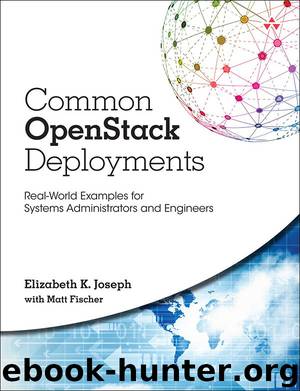Common OpenStack Deployments: Real World Examples for Systems Administrators and Engineers by Elizabeth K. Joseph & Matt Fischer

Author:Elizabeth K. Joseph & Matt Fischer [Joseph, Elizabeth K.]
Language: eng
Format: azw3
Publisher: Pearson Education
Published: 2016-09-15T04:00:00+00:00
Before we launch our Ubuntu instance, we’ll want to do some preliminary work to make sure the instance is accessible and usable when we bring it up. Once again in the left hand menu under Compute, select Access & Security where we will want to edit two sections.
The first section to edit will be Security Groups which will have a default group that we want to edit. Security Groups are used to filter network traffic, and by default there are only a few rules and while they allow outgoing traffic, they block incoming. This means that with the current default rules, you won’t be able to ping or SSH into your instances, which we will want. We’ll also add a rule to allow TCP traffic over port 80 for when we set up a web server in a later step. We’ll start with allowing ICMP ping to the systems, as illustrated in Figure 6.5. Rather than allowing all ICMP traffic, which is an option in the Rule dropdown, we can create a custom ICMP rule to only allow ping. To do this, use the following values:
Rule: Custom ICMP Rule
Direction: Ingress
Type: 8
Code: 0
Remote: CIDR
CIDR: 0.0.0.0/0
Download
This site does not store any files on its server. We only index and link to content provided by other sites. Please contact the content providers to delete copyright contents if any and email us, we'll remove relevant links or contents immediately.
Test-Driven iOS Development with Swift 4 by Dominik Hauser(7898)
Filmora Efficient Editing by Alexander Zacharias(6555)
The Infinite Retina by Robert Scoble Irena Cronin(6059)
Learn Wireshark - Fundamentals of Wireshark. by Lisa Bock(4388)
Linux Device Driver Development Cookbook by Rodolfo Giometti(4008)
Edit Like a Pro with iMovie by Regit(3820)
Linux Administration Best Practices by Scott Alan Miller(2927)
Linux Command Line and Shell Scripting Techniques by Vedran Dakic & Jasmin Redzepagic(2885)
Mastering PowerShell Scripting - Fourth Edition by Chris Dent(2779)
Creative Projects for Rust Programmers by Carlo Milanesi(2612)
MCSA Windows Server 2016 Study Guide: Exam 70-740 by William Panek(2568)
Docker on Windows by Stoneman Elton(2360)
Kali Linux - An Ethical Hacker's Cookbook: End-to-end penetration testing solutions by Sharma Himanshu(2351)
Hands-On AWS Penetration Testing with Kali Linux by Karl Gilbert(2189)
Hands-On Linux for Architects by Denis Salamanca(2119)
Computers For Seniors For Dummies by Nancy C. Muir(2092)
Programming in C (4th Edition) (Developer's Library) by Stephen G. Kochan(2081)
The Old New Thing by Raymond Chen(2033)
Linux Kernel Debugging by Kaiwan N Billimoria(1812)
